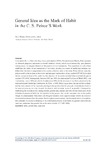Mostrar o rexistro simple do ítem
General Idea as the Mark of Habit in the C.S. Peirce's Work
| dc.contributor.author | Guimarâes Jorge, Ana Maria | es_ES |
| dc.date.accessioned | 2014-10-02T12:31:43Z | |
| dc.date.available | 2014-10-02T12:31:43Z | |
| dc.date.issued | 2012 | es_ES |
| dc.identifier.citation | Culture of communication / Communication of culture, 2012: 887-894. ISBN: 978-84-9749-522-6 | es_ES |
| dc.identifier.isbn | 978-84-9749-522-6 | es_ES |
| dc.identifier.uri | http://hdl.handle.net/2183/13392 | |
| dc.description.abstract | [Abstract] In the article How to Make Our Ideas Clear, published in 1878 by Popular Science Montly, Peirce presents his classical pragmatic maximum «Consider whatever effects, which could conceivably have practical consequences, we imagine inherent to the purpose of our conception». The conception of such effects establishes the whole of our conception of the object, pointing to a sense of intellectual meaning and differs from the idea of pragmatism in the current utilitarian sense at that time. Peirce did not mean that actions could be the purpose or the proper and adequate interpretation of any symbol (CP 5.402) provided that he was not in favor of life under the sole objective of the action detached from a rational thought or purpose (CP 5.429). Subsequently, between 1892 and 1893, his manuscripts The Law of Mind (1892), and Evolutionary Love (1893) provide the foundation in 1898, for the structure of the Habit, presented at the sixth and seventh Cambridge Conferences. In Habit, in 1898, Peirce argues about the one and the multiple, and the real character of the universal, pointing to the question that the principle of retroduction leads in the sense of pursuing the unity between the physical and the mental as much as possible. Consequently, establishing the conceptual link among concept, general idea, concept and habit for the constitution of the embodiment process of habits by the repetition of the general idea, or the composite idea, or the quality brought to consciousness. This article will bring the research in the cognitive scope of habit as a result of he repeated occurrence from the general idea brought to consciousness, introducing the terms «conception» and «concept» to achieve a rereading of the embodiment process of the habits by general ideas from one hand, and understand the general idea as the mark of habit (CP 7.498 1898). | es_ES |
| dc.language.iso | eng | es_ES |
| dc.publisher | Universidade da Coruña | es_ES |
| dc.title | General Idea as the Mark of Habit in the C.S. Peirce's Work | es_ES |
| dc.type | info:eu-repo/semantics/conferenceObject | es_ES |
| dc.rights.access | info:eu-repo/semantics/openAccess | es_ES |






